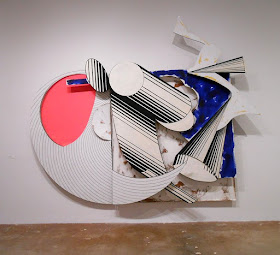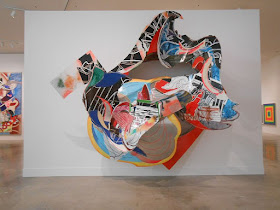"Fortin de las Flores" 1966.
At one point, Stella visited the Philadelphia Museum of Art and saw a 15th century
diptych, a religious painting with two panels, which affected him greatly. He began to
create double images like this one, which you are meant to comprehend at once; it is not
necessary to keep looking for additional meanings.
"Ram Gangra" 1978. "Indian Bird Series. Aluminum. With lattice.
By 1978 Stella felt free to use all the forms he had been experimenting with for years -
the French curve, the protractor, the stripes, and cut them from aluminum and attach
them to a lattice frame projecting far from, but hung on, the wall. He still insisted this
was a "painting."
Side View of "Ram Gangra" showing the lattice background and support as well
as the edges of the honeycomb aluminum.
"Letter on the Deaf and Mute" from the Diderot Series. 1974
Stella has always read philosophy, and he was greatly influenced by the ideas of the
18th century philosophes, like Diderot. This gorgeous work is 12 feet square and
glows with vibrant colors. It is from a private collection in New York; I wonder what
kind of house could accommodate a painting this size?
"Paradoxe sur le comediene" 1974 is another work from the Diderot series.
This is one single work, in the diptych form, about 9 feet high. The stripes of color
vibrate and glow radiantly.
Galleries with "Agua Caliente," a "Black Painting," and "Paradoxe."
Having all of these Stella works together is a pleasure only a few of us will be able
to enjoy; seeing just one of his works in a museum is quite different.
"Anderstorp" 1981 Aluminum. Works now became exceedingly complex.
"Diavolozoppo" 1984. Another series of forms he worked with, because of their
relationship to perception, were cones and columns. This is actually a perfectly flat
work, but by drawing lines receding, he gives the illusion of depth and space.
"Cetology" 1991 Aluminum is part of the Moby Dick Series, which he continues
to work with. Sheets of aluminum are bent and curved here, not cut and positioned.
"Cetology" seen from the side. This is the same piece as above, but it looks
completely different from the side. Notice that it is still hung on a hook on the wall;
it does not stand on its own, like a sculpture.
"Playskool: Clamp" 1983. In 1983 Stella made a whole series of small pieces from
found objects. He gave all of them the title "Playskool" as a matter of convenience.
He had first worked in what he considered a perfectly rational, orderly manner in
creating art, but he gradually came to feel that there was also a side to nature and
to his mind that was not always rational or orderly; as a matter of fact, "chaos" also
seemed to be a natural part of life. He here explores that idea.
"Playskool: Gym" 1983. Found objects.
"Playskool: Sink" 1983. Found objects.
"The Pequod Meets the Virgin" 1998. Aluminum. From Moby Dick Series.
You can see waves and fins and blood and the ocean and more.
"Her Name was Marianne Congreve . . . " from a poem by Kleist, a German poet. 1998
The forms and colors he uses became ever more complex.
"Her Name was Marianne" seen from the side.
"The Musket" 1995. Aluminum.
This is one of the largest aluminum sheet and aluminum honeycomb pieces.
"K 37" from Scarlatti Sonata Kirkpatrick Series. 2008
Stella constantly tried out new processes and materials; he became proficient in
computer graphics. He began to use steel piping as a 3D line in his sculptures.
The lattice work here is smaller and looks like a skeleton. This is about ten feet high
and hangs from a hook on the wall.
"Hooloomooloo 1, 2, 3" 1995 from "Imaginary Places Series."
By 1995 Stella was using computer generated images and collage to create his pieces.
Often he would first construct a collage of many different materials, then take a photograph
of it and put it into a computer, print it as an image, project it on the wall so that he could
then paint a canvas with the image. The depth and space become enormous.
"Central Panel of Hooloomooloo 2." 1995
You can see the many computer generated images he has created and projected on the wall
and then painted as skeins of lines. The dots began as random forms and gradually
emerged as stronger and larger elements.
"Hooloomooloo IV" actually belongs to a Post Office in New England.
It is on loan to the show while renovation goes on in the office.
"Hooloomooloo IV" detail. You can see the many computer generated images
and color dots and how they interact in the composition.
"Hooloomooloo V - Imaginary Places" is on the arch above the entry to the museum.
"Hooloomooloo V - Imaginary Places."
"Hooloomooloo VI - Imaginary Places" was made in 2015 and stands 14 feet high.
To me, the form looks like a Japanese kimono hung up to show, and the images in
the work look like intricate stitches in the pattern of a silk kimono.
It is very interesting.
"The Fountain - from the Moby Dick Series" 1992
The novel "Moby Dick" with its themes of nature and man, power and loss of power,
the great ocean and great whale, suggest all sorts of feelings. Stella has used the title in
many of his works over the years. He is always influenced by many things around him.
This work shows the strong influence of Henry Matisse.
"The Fountain - Moby Dick Series." The black and white figure looks much like the
"Blue Nudes" of Matisse and the cut-outs of "La Negresse" by Matisse. Cones and
columns are visible, as are computer images.
"The Earthquake in Chile" 1999 collage. Stella often works with collage in
preparation for later painted or sculpted works, but the collages also stand by themselves,
with intricate complex imagery and questions of perception.
Close-up of "Earthquake in Chile" showing collage elements.
Study for "Princess of Wales Project in Toronto" 1992. Collage.
Another study for "Princess of Wales Project - Toronto." 1992
Close-up of "Princess of Wales Project." Collage.
"Leeuwarden II" 2017. Steel and Aluminum.
"Hercules and Archelous." 2017. Steel and Aluminum.
This piece is puzzling; it is attached to the wall, but it is also standing on the ground.
But more puzzling is - how to see it. This is the view from the front? side? and it
looks understandable. But if I walk around it, below
This is the view from the "back." It is also very interesting and comprehensible.
But how do the two side fit together? What do they mean?
"K 144 - Scarlatti Sonatas Kirkpatrick." Steel tubing and aluminum. 2017
This is 8 feet high and it projects several feet from the wall and it hangs on two hooks.
Stella has now done more than 150 pieces with tubing and other materials in creating
free form objects.
"Atalante and Hippomenes" 2017. Steel, Aluminum, and Fiberglass.
"Jay's Star" 2017 Stainless Steel.
The large room is filled with drawings, sketches, and models which Stella has used
in completing oil paintings and sculpture; they allow us to see his mind working.
Stella models.
A model for a later aluminum piece.
__















































































